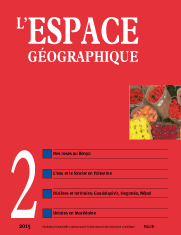

Water and land trajectories in the construction of territories
Water and land tenure in the construction of multi-sited territories: The Palestinian case (3 fig.)
The concept of multi-sited territory is used to understand the evolution of social interactions concerning space and resources. Exploring social interactions concerning land and water tenure, we reconstruct territories as they are experienced. This reveals functional ties linking spaces which appear scattered at first sight as well as the dimensions along which such noncontiguous spaces constitute a single territory. This sheds light on the divergent, sometimes conflicting, evolutions, of various, multi-sited territories that are imbricated nonetheless. The extreme fragmentation of the West Bank illustrates the usefulness of this approach.
keyword: LAND TENURE, LEGAL PLURALISM, MULTI-SITED TERRITORY, PALESTINE, WATER
Rice in the Guadalquivir marismas: worth its salt? (5 fig.)
Based on the case of brackish marshes, or marismas, in the Guadalquivir estuary, this paper studies over the long term the construction of socio-natures and the dynamics of space appropriation through land and water management. It analyzes more specifically the material and discursive devices, the historical tensions and contingencies that allowed spatially and politically shaping the suitability of some of these marshes for growing irrigated rice. It studies the competition and the compromises, which have played out since the XIXth century between three projects of land and/or water management for navigation, irrigation, and wild life protection; and their impacts.
keyword: LAND TENURE, POLITICAL GEOGRAPHY, RICE FARMING, SALT, TERRITORIAL PROCESS, WATER
Environment, ecologisation of politics, and territorialisations: New water policies (GIRE and PES) in Kenya (4 fig.; 1 tabl.)
A Payment for Ecosystemic Services (PES) program was implemented in 2010 around the Naivasha basin, Kenya’s main rose growing region for European export. The major water consumers at the lake’s edge use the program to offer financial incentives to small-scale farmers upstream to adopt smart agricultural practices restraining soil erosion. Beyond a critical analysis of the political ecology of the PES program, this article examines how the system links territories that are diametrically opposed and how it fits into a territorial redefinition of water policies in Kenya.
keyword: INTEGRATED WATER MANAGEMENT, KENYA, PAYMENT FOR ECOSYSTEMIC SERVICES, TERRITORY, WATER
The territorialization of Uganda’s Olweny swamps: Agricultural and environmental policies versus power struggles (3 fig.)
In the heart of the Olweny swamps, located in the Lango sub-region of northern Uganda, within the African Great Lakes Region, a territorial project is being implemented. However, transforming these wetlands into irrigated rice paddies is not limited to the institutionalization of agricultural areas associated with intensified agricultural. Rather, social representations, the physical materiality of land, and local practices through land and water management are the expression of territorialities participating in the hydraulic territorialization of the Olweny swamps.
keyword: HYDRO-AGRICULTURAL PROJECT, LAND, POWER STRUGGLES, SWAMP, TERRITORIALIZATION, WATER
The creation of Nepal’s rice-growing plain: Water management and territorialization processes in the Sunsari district (3 fig.)
The Nepalese plain, a formerly marginalised area, has undergone dramatic changes over the last fifty years to become Nepal's granary. This process derives from an ancient ideology that led to the introduction of land policies and then of large hydraulic infrastructures. This paper studies the subsequent changes in the population’s relationship to land and water, and in the territoriality of the different groups of actors involved. It analyses the co-construction of the management of hydraulic facilities through social dynamics and its imprint on the territory. It also demonstrates how the former marginalised situation can explain certain social conflicts, which can be observed in the management of water resources.
keyword: LAND HOLDING, MARGIN, SOCIAL CONFLIT, TERRITORIALITY, WATER
Uniates in the Balkans – geographical considerations on religion of the “lands between” in the Republic of Macedonia (3 fig.; 3 photos)
Uniatism is a marginal and yet highly revealing movement in the Balkanic universe of the “in-between”. It established itself as a sustainable third way for certain Slavic communities within the Ottoman Empire looking to break with the Orthodox Church in 19th century and to unite with Rome. Uniatism has persisted until today in the region of Strumitsa (Macedonia), despite significant changes in its identity. This article aims to define the geographical identity of this population regarding the third Europe through a multiscalar approach which contextualizes the Uniates’ identification with a place of origin, a cultural group, and the nation.
keyword: BALKANS, EUROPE, IN-BETWEEN, MACEDONIA, RELIGION, UNIAT
Book reviews
In this issue of l’Espace géographique, you will find critical reviews of the following books
DUVAT V., MAGNAN A. (2014). Des catastrophes naturelles. Paris: Le Pommier, 312 p. (Augustin Berque, EHESS) ISBN: 978-2-7465-0679-4
CHALEARD J.-L. (dir.)(2014). Métropoles aux Suds, le défi des périphéries. Paris: Karthala, coll. «Hommes et Sociétés», 442 p. (Jean-Paul Deler, CNRS Bordeaux) ISBN: 978-2-8111-1054-3
BERGEL P., MILLIOT V. (2014). La Ville en ébullition. Sociétés urbaines à l’épreuve. Rennes: Presses universitaires de Rennes, coll. «Histoire», 384 p. (Marie Morelle, université Paris 1 Panthéon-Sorbonne) ISBN: 978-2-7535-3454-4
L’espace géographique 1/15![]()
![]() L’espace géographique 3/15
L’espace géographique 3/15
For subscribe or buy this issue: BELIN
![]() L’Espace géographique: contents
L’Espace géographique: contents
Last modified: october 27, 2015